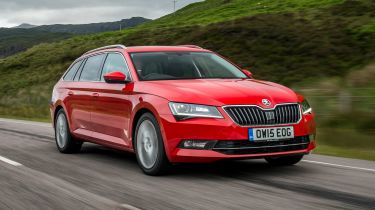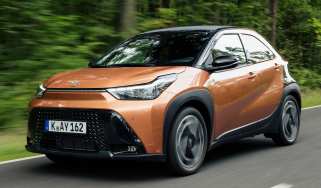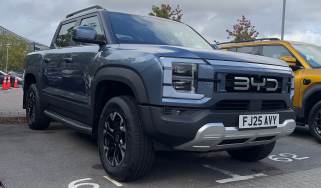Skoda Superb Estate (2015-2024) review
The Superb Estate is the ultimate family wagon, as it offers huge space in a stylish and comfortable package

Just to let you know, this is an older review of the 2015-2024 Skoda Superb Estate. If you are interested in information about the latest Skoda Superb Estate, or news of upcoming Skoda models, please follow the links provided.
The Skoda Superb is in its third generation, and this version is easily the best yet. While it carries on the tradition of past Superbs by offering acres of space and decent quality in a great value package, the Mk3 has the good looks to make it an attractive choice for family car buyers.
There wasn't an estate variant of the original Superb, sold from 2001-2008, but the second generation model (2008-2015) was offered as a load lugger, and the current car is also sold as an estate. And what an estate it is. There is a vast amount of space inside, with a boot that expands from 660-litres with the seats up to a maximum of 1,950 litres with the seats down. That's more than you get in the Mercedes E-Class Estate and is on a par with the Volvo XC90 large SUV, too.
But boot space hasn't been created at the expense of rear passenger room. The original Superb was based on a design for an extended wheelbase VW Passat, so it had generous legroom. The second car had more room, and the current car is second only to the long-wheelbase Audi A8 L limousine for rear legroom in the VW Group.
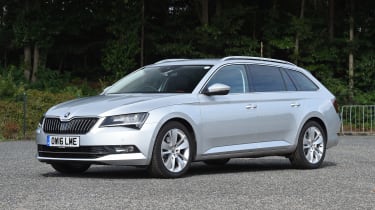
One highlight of the Superb is that it leaves behind the frumpy looks of its predecessors, with plenty of sharp edges and defined body creases. It's arguable that the Superb Estate is better looking than the Superb Hatch. There are angular LED tail-lights, a steeply raked rear windscreen and a gently sloping roof line.
Used - available now

2023 Skoda
Superb
48,015 milesAutomaticPetrol1.4L
Cash £15,849
2021 Skoda
Superb
56,948 milesAutomaticDiesel2.0L
Cash £19,699
2023 Skoda
Superb
40,850 milesAutomaticPetrol1.4L
Cash £19,299
2023 Skoda
Superb
37,430 milesAutomaticPetrol1.4L
Cash £16,699The Superb comes in six different trim levels – S, SE, SE Technology, SE L Executive, SportLine and Laurin & Klement. Even entry-level models gett 16-inch alloys and a five-inch touchscreen. At the top of the range the L&K models get 18-inch wheels, leather trim, an eight-inch screen with sat-nav and a 10-speaker stereo.
Under the bonnet, the Superb gets a wide range of petrol and diesel engines. In petrol guise, there's a 1.4 TSI 125PS, a 1.4 TSI 150PS with cylinder deactivation to help save fuel, and a 2.0 TSI with either 220PS or 280PS. The latter in SportLine trim is as close as you'll get to a Superb vRS, as the engine is the same as the one found in the Octavia vRS.
Diesels are expected to take up the buk of sales, as their torquey power delivery boosts carrying and towing capacity. There's a 1.6 TDI 120PS that comes in fuel-efficient Greenline guise, and a 2.0 TSI with 150PS or 190PS.
All cars get a six-speed manual gearbox, while most engines are available with a twin-clutch DSG gearbox, too. Four-wheel drive is also available on selected models. All the latest technology is offered including lane keep assist, adaptive cruise control, park assist and Smart Link compatible with Apple and Android smart phones.
The Superb Estate isn't just the current benchmark for the family estate car class, it's one of the best estates cars in any class. Its most direct rivals include the Volkswagen Passat Estate, which shares a similar platform, but isn't as spacious and is more expensive, plus family estate rivals such as the Mazda 6 Tourer, Ford Mondeo Estate, Hyundai i40 Tourer, Kia Optima Sportswagon, Peugeot 508 SW, Vauxhall Insignia Sports Tourer and Toyota Avensis Touring Sports.
In terms of boot space, the Superb is a great value alternative to cars such as the aforementioned Mercedes E-Class, as well as the Audi A6 Avant, BMW 5 Series Touring and Volvo V90. Not only can it rival them for space, it can also come close for quality and kit.
The Superb Estate’s mix of qualities meant it was our 2016 Estate Car of the Year at the New Car Awards. It’s affordable, efficient, practical and fun to drive, so it ticks all of the boxes for any growing family, plus it won't cost the earth to run.
It's also one of the most handsome looking cars in its class, with sleek lines and well thought out cabin. Kit levels are generous across the range and a vast array of engine options means there should be something for everyone.
It's primarily a big, soft, comfortable cruiser, and most versions won't set the world alight in terms of performance, but the Superb Estate is still surprisingly capable if you point it at a twisty road. That's because it's lighter than you would expect, so it's pretty nimble for such a large car. With the extra practicality benefits the estate brings over the hatch, we'd say this is the one to go for, too.
Engines, performance and drive
Skoda is owned by Volkswagen, so the Superb Estate sits on the same VW Group MQB chassis that underpins the VW Passat Estate. This versatile platform stretches from small cars like the VW Golf to large estates like the Superb. It delivers lots of comfort when you’re cruising on the motorway, but given the Superb’s size, it’s also impressive how hard you can drive it, as the chassis gives it plenty of control and composure.
As you would expect, compared to the Superb hatchback, the driving experience in the Estate is virtually identical. There’s a fraction more body roll in fast corners, but then the Superb is no sports car, so don’t let that put you off.
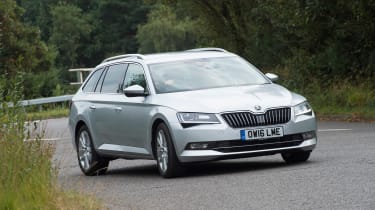
Stick with the standard six-speed manual gearbox and the shift action is effortless, without a mm of slack, but the £1,400 DSG gearbox does add another layer of sophistication.
Refinement is particularly impressive – even at 100mph on a German Autobahn you can have a conversation with you passengers without raising your voice. The suspension is supple by default, but can be tightened up if you order the £750 Dynamic Chassis Control pack, which adds adaptive dampers. But even without the electronically adjustable suspension, the Superb’s ride is composed and controlled.
All Superbs feature switchable driving modes, ranging from more comfortable settings to sportier modes that sharpen the throttle, steering and adjust the firmness of the suspension if adaptive dampers are fitted.
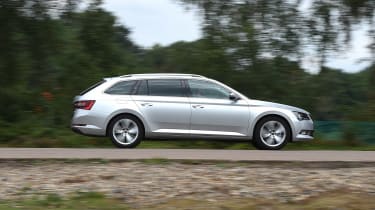
The body glides over bumpy roads thanks to its soft set-up, but the dampers never lose control. You hear big bumps more than you feel them, as even on 18-inch wheels the Skoda copes impressively with harsh lumps in the tarmac.
This control means the steering is precise, so for a big car, the Superb changes direction well. It’s just the right weight and speed; it makes it easy to manoeuvre but also more fun to drive than you might think on twisty roads.
Engines
The 1.4 TSI engine is smooth and virtually silent and comes with 123bhp or 148bhp, plus there’s a range-topping 276bhp 2.0 TSI 4x4, but it’s the diesel that make the most sense.
Our pick of the range is the 148bhp 2.0 TDI that delivers plenty of performance for hauling you, your family and a big boot full of luggage along, but never sounds overly strained.
There’s enough power that this version of the Skoda doesn’t feel slow on the road, thanks in partto its 1,445kg kerbweight, and when we tested the 2.0 TSI 150PS with DSG gearbox, it showed a strong turn of speed. We managed 0-60mph in 8.7 seconds, and in-gear times between 30-50mph were strong. Thi is only slightly slower than the Volkswagen Passat Estate with the same engine, but in the real world, the difference is barely noticeable.
The gutsy but refined engine revs smoothly and is helped by the swift-shifting six-speed DSG box. It changes up early in normal driving to maximise efficiency, but put your foot down and use the transmission’s manual mode, and the shifts are snappy.
In auto, it’s quick to kick down when you ask for full throttle, but the effortless progress in auto is what makes the Skoda such a relaxed cruiser on the motorway and easy around town.
MPG, CO2 and Running Costs
The cleanest model in the Superb Estate range is the 118bhp 1.6 TDI 120PS Greenline. It returns a claimed 76.4mpg and CO2 emissions of 97g/km.
However, a whole host of other diesel models aren’t far behind that, including our pick – the 148bhp 2.0 TDI – that manages 68.9mpg and 109g/km. Order the same engine with a DSG gearbox and that falls to 61.4mpg and 121g/km. However, even the 187bhp 2.0 TDI 4x4 DSG model returns 55.4mpg and 135g/km.
With fleet buyers expected to make up the majority of Superb Estate sales, BIK rates are crucial. The model with the lowest BIK rate is in fact the 148bhp 1.4 TSI petrol that returns 55.4mpg and 119g/km, with BIK of 18 per cent.
All Superbs come with a three-year, 60,000 miles warranty, and are available with a variety of fixed-price servicing packs to help manage costs.
Insurance groups
The Superb will be largely inexpensive to insure with groups that start from 12 and rise to 27 for the 276bhp range-topper. Mid-spec diesel models attract an insurance of 18 or 19.
Depreciation
After three years you can expect the Superb to retain between 40 and 49 per cent of its value. As an example, the 2.0 TDI 150PS DSG SE L Executive has a predicted residual of around 46 per cent. Combine this with a comparatively lower list price than a VW Passat Estate with the same transmission and in similarly priced SE Business spec, and the Skoda is slightly ahead of its closest rival.
Interior, design and technology
According to Skoda the previous generation Superb Estate outsold the Hatchback because it didn’t look quite so awkward – in reality, neither of them were lookers. This time around however, both models are genuinely desirable in their own right.
The Estate has a very simple shape, defined by its role as practical family transport. But there are some neat design details that lift the styling from the ordinary to classy, understated elegance. Take the chrome grille with its upright slats. It’s framed by the sharp headlights, while underneath there’s another full-width air intake that underscores the crisp design.
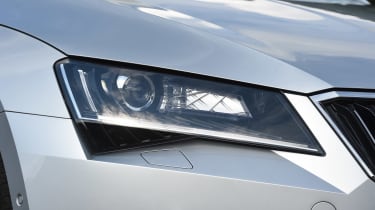
The Superb’s panels are broken up by incredibly sharp creases down its flanks that flow back from the headlights and along the car to the rear wings, while underneath these styling lines, a chunky cut-out section catches the light to break up the blocky surfaces.
The crisp, clean lines and chrome-edged glass area mean the Superb is unfussy and simple, but with 18-inch wheels on SE L Executive models and above, they work nicely with the body’s proportions, there’s just enough of a sporty hint to the styling.
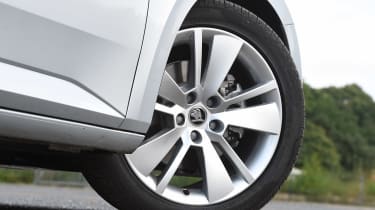
At the rear, the Superb's tailgate is heavily raked, following the line of the sloping C-pillar. This helps make it look less bulky from behind and almost gives the Skoda a shooting brake-style shape in profile. Together with the silver roof rails and extra chrome inserts at the front, there are plenty of details to lift the reserved shape.
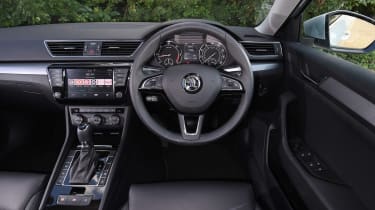
It’s a similar story inside, as the angular exterior design is repeated with a vast dash that sits high up across the car without dropping away. It gives plenty of space for an eight-inch touchscreen, while the large heater controls underneath feel sturdy to touch.
One of the biggest triumphs inside the Superb is the quality of the materials. It can't quite match a VW Passat in a few minor areas, but materials on the whole are on a par with the big Volkswagen.
Sat-nav, stereo and infotainment
On the inside the overall design is more basic, with a rectangular touchscreen, ranging from five to eight inches in size, in the middle of the dash and a series of simple horizontal trim pieces emphasising the car’s width.
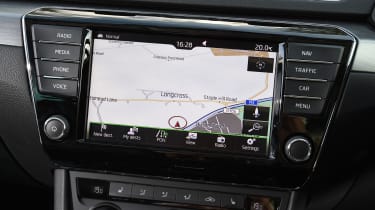
All the controls are where you’d expect them to be, however, and feel solid to the touch. In fact, all the cabin materials are top notch – not quite on a par with its MQB platform-based sister car, the VW Passat, but robust and built to last nonetheless.
Practicality, comfort and boot space
The Superb boasts more boot space than many of its rivals with the seats up or down, and it teams this with an equally practical cabin. There’s lots of room throughout, and storage is good, too.
Skoda offers plenty of what it calls ‘Simply Clever’ solutions to add extra little touches of practicality which should make the car easier to live with. This includes an LED torch in the boot, an ice scraper in the fuel filler flap and two umbrellas hidden in the front doors. These thoughtful additions make living with the Superb simple and stress-free.
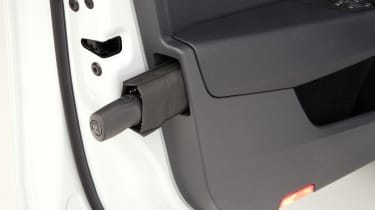
There are a few Estate-only options available to boost versatility too, including a variable boot floor for extra storage at around £150, and a £1,150 panoramic glass roof – although the cabin doesn’t necessarily need the extra light as it feels spacious enough.
Size
The boot can accommodate long objects up to 3.3m in length, too, if you fold the front passenger seat forward. It’s the way that Skoda has made all that space so useable that really impresses, though.
For example, the edges of the tailgate (electrically-powered as an option, or standard on top-spec models) are pushed right to the outer edges of the car making the opening massively wide, with a low loading lip.
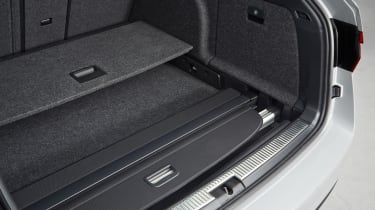
The rear seats fall forward automatically via a pair of levers in the boot, and the expansive loading are can be configured in a variety of ways using Velcro luggage dividers, a variety of shopping bag hooks and an optional moveable false floor.
Leg room, head room & passenger space
The interior is also covered with clever solutions to make your life easier, including an ice-scraper in the fuel filler cap, umbrellas slotted into the front doors and grippy cup holders so you can unscrew the cap with one hand.
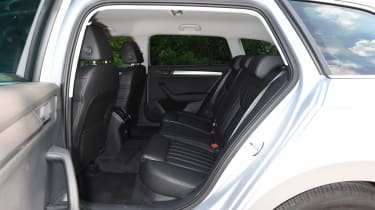
An iPad cradle can be clipped into the back of the front headrests, or between the rear seats, and even the very tallest passengers will have leg and headroom to spare.
Boot
In terms of numbers, the Superb Estate is head and shoulders above the rest of the class. In fact, with boot space of 660-litres (27-litres more than its predecessor), or 1,950-litres with the rear seats folded, it’s got more room back there than the Mercedes E-Class Estate.
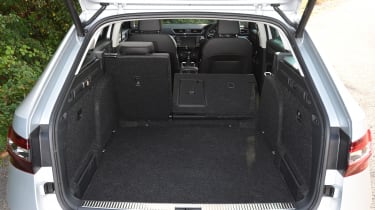
Reliability and Safety
Like the smaller Octavia, the Superb is based on the VW Group’s modular MQB platform (it's also used on cars such as the VW Passat, Audi A3 and SEAT Leon all use versions of the same chassis), which brings with it the benefits of producing components and engines on a huge scale.
Because it shares many of its mechanical bits with other models you can rest assured that any deficiencies have been ironed out. The previous generation Superb came an impressive 12th overall in our 2015 Driver Power customer satisfaction survey with a score of 94.5%, and there’s no reason to doubt this new Estate model won’t be better still.
The new Superb is also the most technologically advanced and safest Skoda ever built with a vast range of electronic safety systems. These include blind spot detection, to prevent you changing lanes when another car is there, and Lane Assist that nudges the steering wheel automatically to keep you within the lines in your lane.
Lane Assist works with the adaptive cruise control system for the Traffic Jam Assist function that accelerates, brakes and steers the car for you in jams. Rear Traffic Alert warns you, then brakes the car if something is coming, when you’re reversing out of a parking bay.
Warranty
All Superbs come with a three-year warranty but unfortunately it is capped at 60,000 miles. An extension to five years or 100,000 miles will cost a further £630.
Servicing
It costs £139 for an intermediate (10,000 mile) and £259 for a full (20,000 mile) service. You can opt for a fixed price service plan, starting at £479 for three years/30,000 miles.

